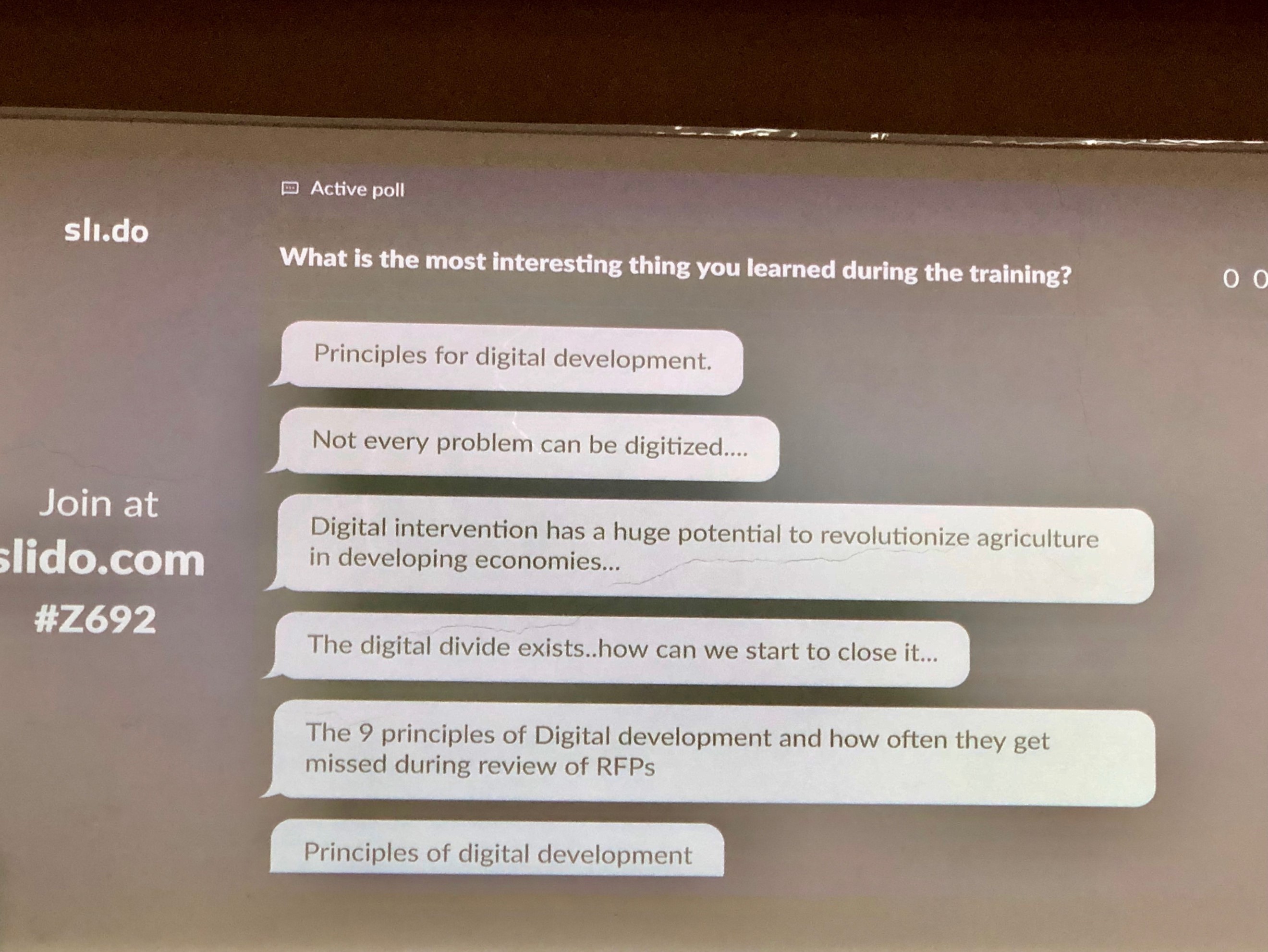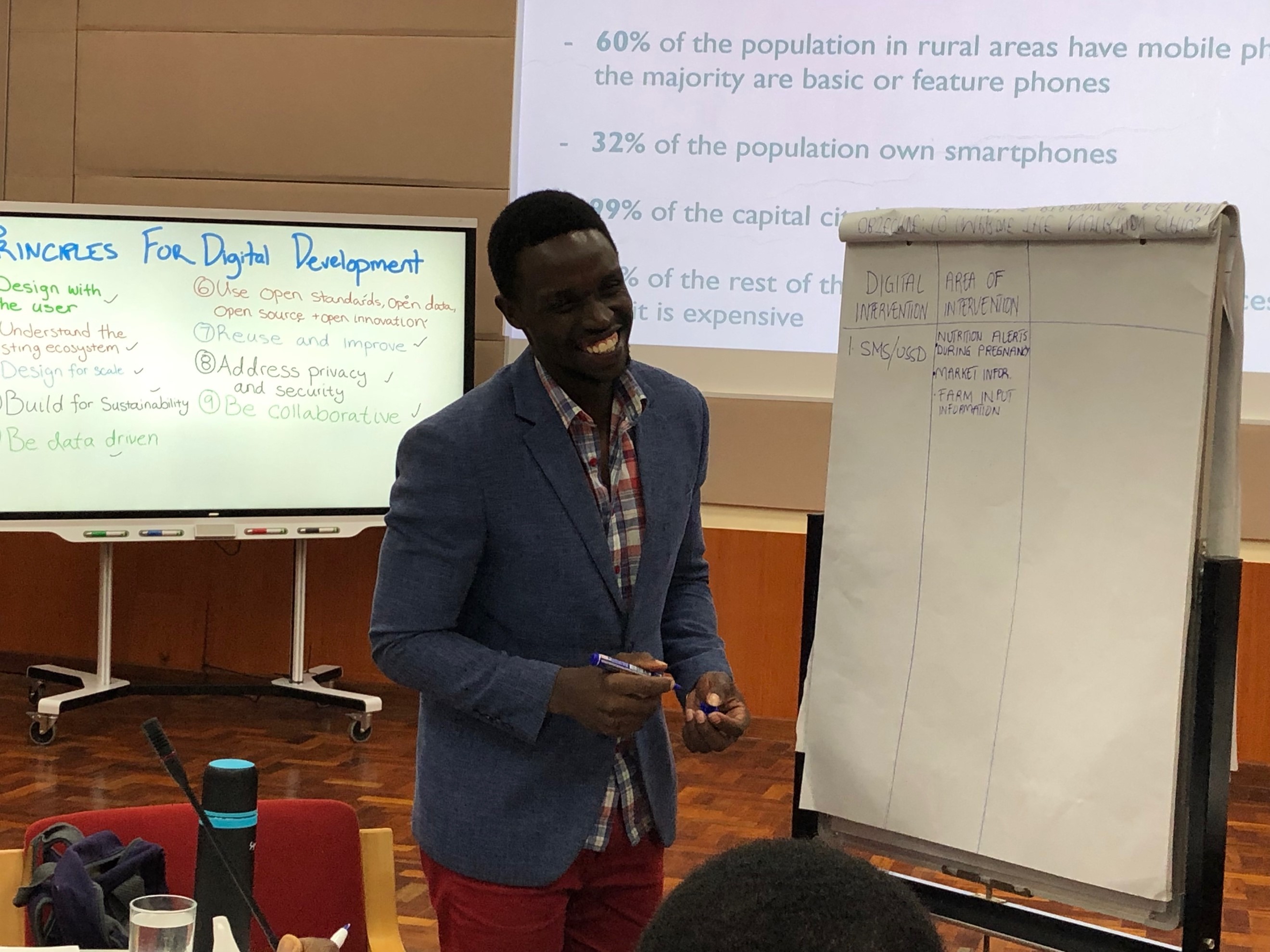Let us know what type of content you'd like to see more of. Fill out our three question survey.
Applying the Principles for Digital Development in a Flourishing Digital Ecosystem
Sep 19, 2019
As a co-facilitator at a recent Feed the Future training on digital development for resilience and food security in Nairobi, I was struck by the stark contrast between the short amount of time (a scant four years) I’ve been settling debts with friends on Venmo and the participants’ resounding “we’ve been using it forever” response when I asked how long they had been using Kenya’s mobile payment system, M-Pesa. While I can imagine a world without Venmo, it is clear that, for many Kenyans, life without M-Pesa is inconceivable.
I point out the ubiquity of M-Pesa because not only did it revolutionize the way people spend, save, and send money, it was also a catalyst for Kenya’s thriving digital ecosystem and, in many respects, a model for the training I gave that day.
Kenya’s agriculture sector is leading the region in digital innovation. In fact, according to a recent report, Kenya has the most digital agriculture enterprises and users in sub-Saharan Africa. Not only are there more than 100 solutions in the market, 20 to 30 percent of Kenyan farmers are engaging with more than one digital solution, pointing potentially to the success of these solutions in easing critical pain points for smallholder farmers, crop buyers, and agribusinesses alike.
Some of the agricultural digital innovations highlighted by the training participants included:
-
Twiga: a mobile app enabling linkages between farmers and vendors
-
Tulaa: a mobile money solution that allows farmers to access inputs, credit, and markets
-
Pula: a technology-driven agriculture insurance offering
-
aWhere: an AI-supported platform for real-time weather data to reduce the risks associated with agricultural practices
-
DigiFarm: a consumer-facing mobile app providing an agribusiness solution for smallholder farmers to buy inputs and access finance, and agrilearning content
-
WeFarm: the world’s largest farmer-to-farmer digital network
-
The Talking Book: engaging, culturally relevant audio content delivered through low-tech audio devices
Given the diversity of digital applications for resilience and food security programming , the training delivered sessions on a wide variety of digital tools, ranging from communication technologies and hardware to sensors and precision agriculture, blockchain, and AI. Personally, I consider the latter of these topics to be the most exciting; however, to my surprise, as the training progressed it became clear that the topic of most interest to participants was The Principles for Digital Development.

Live polling from the final day of the training highlighted the strong resonance of the Digital Principles.
So, What are the Principles?
The Principles for Digital Development are nine living guidelines designed to help development practitioners integrate best practices into technology-enabled programs. They are:
-
Design with the user
-
Understanding the existing ecosystem
-
Design for scale
-
Build for sustainability
-
Be data-driven
-
Use open standards, open data, open source, and open innovation
-
Reuse and improve
-
Address privacy and security
-
Be collaborative
Practice, Practice, Practice
Throughout the training, participants took part in group activities that simulated the application of the Digital Principles. They tried their hand at designing “know your user” questionnaires, evaluating a digital intervention against a hypothetical target user, and interpreting an ecosystem assessment. These activities culminated with a final project in which participants designed a digital intervention.
As I watched participants present their designs in the form of skits, videos, and animated PowerPoint presentations, I was impressed not only by the creativity of their solutions, but also by the ways in which participants adopted and internalized the Digital Principles. For example, one group outlined an intervention that leveraged mobile money for a cash transfer program. They identified important user-level information around trust networks and digital literacy and decided to to distribute money using mobile money channels to local religious leaders instead of directly to the recipients.
If the participants had designed their digital interventions on day one of the training, prior to the session on the Digital Principles, they would have been drastically different from the products they presented on day four. According to the training pre-survey, most participants had never been exposed to the Principles. On their way out the door, it was clear that they were not only thinking about how to integrate the Principles into their daily work, but also how to share the concepts with their colleagues and networks.

Group activity session for developing digital interventions based on the Principles for Digital Development.
Key Takeaways
This training made it clear that even in countries with a flourishing digital innovation ecosystem and an abundance of effective digital solutions, it is important to be grounded by the Digital Principles. As development practitioners, it falls on our shoulders to spread awareness of these Principles and to provide opportunities to practice, apply, and experiment with putting them into action.
It was evident that the participants had a strong appetite for adopting the Digital Principles, which speaks to the need to distribute this information to people outside of this small group, who can’t consume what they don’t know exists. After the training, it is imperative that participants find ways to share the Digital Principles with their networks.
Taking a step back, this training begs the question of what the adoption and practice of the Digital Principles might look like in less-developed digital ecosystems. It is up to us as development professionals to explore this and support their dissemination.